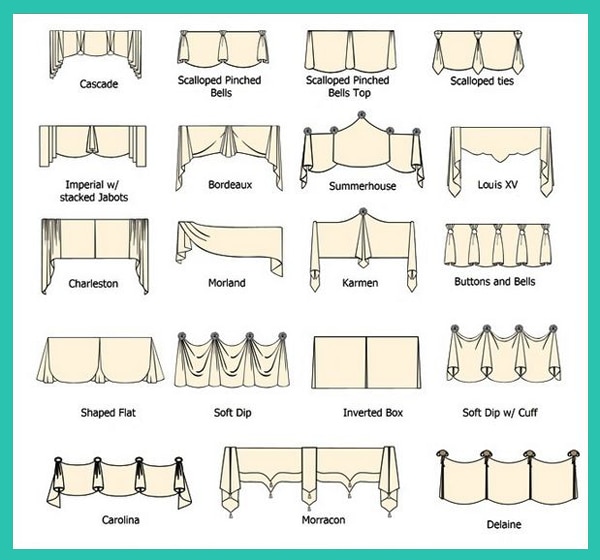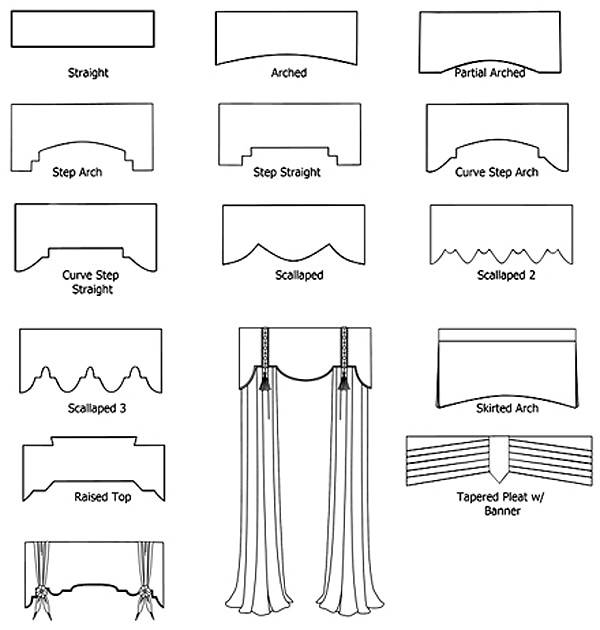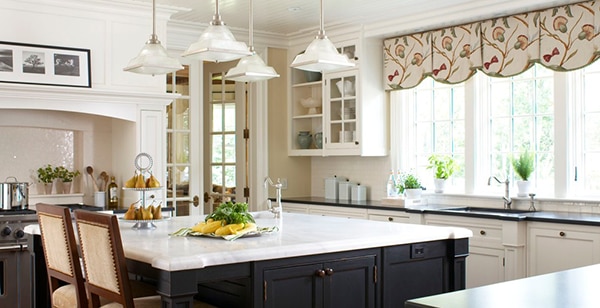Window treatment terminology is tricky. If you have ever felt confused about the difference between a cornice and valance, you are not alone. Both valances and cornices top off your window to add a decorative touch, but there’s a distinct difference between the two. Sometimes lumped together and used interchangeably, after today you will be able to clearly determine the difference between these two confusing window treatment types.
A valance is sort of like a very short drapery panel that only sits at the top of the window. Installed with either a curtain or drapery rod or stapled to a back board, a valance always has a soft appearance that can look casual or formal depending on which style your going for. With fabric hanging freely at the top of the window, valances instantly create interest when paired with other window treatments. Sometimes, you don’t even want to bog down your beautiful view with bulky window treatments. A valance by itself looks just as good as a fully decked out window when you don’t have the desire to block a great view but still want some sort of visual interest. Like the cherry on top of a sundae, valances are the finishing touch on your delicious window design.

A corniceis similar to a valance in the sense that they both top off your window treatment. Used to hide window treatment hardware or just to add a pop of color to the room, cornices are a great addition to your interior design. What makes a cornice different from a valance is how it is constructed. Cornices are hard top treatments, meaning the fabric is often created by upholstering a board with no loose fabric hanging at the bottom. Made in various shapes and sizes, you can vary them with different fabrics or shapes depending on the look you’re going for.

Whether you prefer the more structured look of a cornice or you like the soft feel of valances, you can have some flexibility in how you decide to top off your window treatments to add interest up the entire length of the wall.
Find the perfect valance or cornice to suit your style at Blindsgalore
Difference Between Valance and Cornice
The primary difference between a cornice and a valance lies in their construction and appearance. While both serve as decorative window toppers, they offer distinctly different aesthetic and functional qualities.
Construction and Material
A valance is a soft, fabric-based window treatment that hangs loosely at the top of a window. It functions like a very short drapery panel with fabric hanging freely, creating a soft appearance that can look casual or formal depending on the style chosen. Valances are typically made from various fabrics including cotton, silk, or synthetic materials and can be installed with curtain rods or stapled to a backboard.
A cornice, on the other hand, is a hard, structural element typically made from wood, MDF (medium-density fiberboard), or other sturdy materials. Cornices are rigid, box-like structures that can be upholstered with fabric or finished with paint or stain. The fabric is created by upholstering a board with no loose fabric hanging at the bottom.
Key Feature Comparison
| Feature | Valance | Cornice |
| Construction | Soft, loose-hanging fabric | Hard, rigid box-like structure |
| Material | Fabric panels | Wood, MDF, or sturdy materials (often upholstered) |
| Appearance | Soft, relaxed, casual to formal | Structured, polished, sophisticated |
| Installation | Easy DIY installation | Often requires professional installation |
| Cost | Generally more budget-friendly | Higher cost due to materials and complexity |
| Flexibility | Easy to change and update | Less flexible once installed |
| Best Suited For | Casual, rustic, eclectic styles | Formal, traditional, contemporary settings |
| Maintenance | May need frequent cleaning | Minimal maintenance, mainly dusting |
| Customization | Wide variety of styles and fabrics | High customization with architectural details |
Functional Similarities
Both valances and cornices serve several important functions:
- Hide window treatment hardware for a clean, polished aesthetic
- Block additional light from the top of windows, ideal for pairing with blackout treatments
- Add decorative appeal and visual interest to window treatments
- Create a finished look that enhances overall room design
Style and Design Considerations
Valances offer versatility in styles including gathered, pleated, scalloped, and tailored designs. They provide a softer, more relaxed aesthetic and are ideal for spaces where you want warmth and casual elegance. Modern valance trends favor sleek, straight-across designs with subtle pleats and neutral tones.
Cornices provide clean, structured lines with smooth surfaces ideal for showcasing bold prints or geometric patterns. They can be customized with various shapes, arches, decorative moldings, and embellishments like nailhead trim or welting. Cornices are particularly effective in formal dining rooms, professional spaces, or areas viewed from above like staircases.
Installation and Practicality
Valances are generally easier to install and can often be a DIY project with basic tools and skills. They can be mounted inside or outside the window frame using decorative hardware or boards.
Cornices typically require professional installation due to their weight and the need for precise measurements. However, they offer superior durability and longevity, especially when made from high-quality materials.
Both window treatments can be used alone or paired with other window coverings like curtains, blinds, or shades to create layered looks that maximize both aesthetic appeal and functionality.

